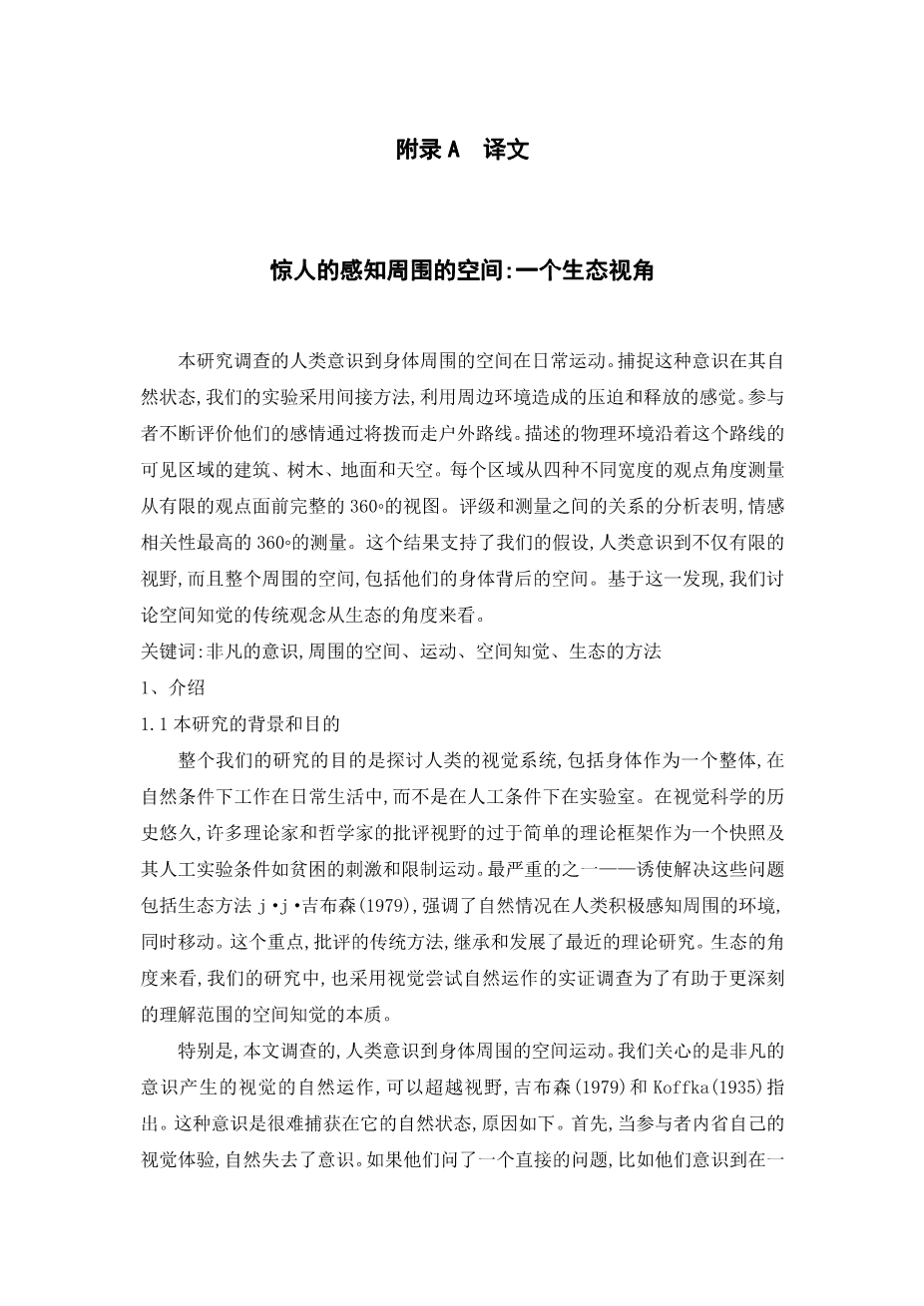惊人的感知周围的空间:一个生态视角外文翻译资料
2023-05-31 19:47:40
附录B 外文原文
Phenomenal Awareness of the Surrounding Space: An Ecological Perspective
This study investigates the extent to which humans are aware of the space surrounding their bodies during daily locomotion. To capture this awareness in its natural state, our experiment adopted an indirect method that uses feelings of oppression and release caused by the surrounding environment. Participants continuously rated their feelings by turning a dial while walking along an outdoor route. The physical environment along this route was described in terms of the visible areas of buildings, trees, ground, and sky. Each area was measured from four different widths of view angles ranging from a limited view in front to a full360◦ view. Analysis of the relationship between the ratings and measurements reveals that the feelings have the highest correlation with the360◦ measurements. This result supports our hypothesis that humans are aware not only of the limited visual field but also of the entire surrounding space, including the space behind their bodies. Based on this finding, we discuss the traditional concept of spatial perception from an ecological perspective.
Keywords: phenomenal awareness, surrounding space, locomotion, spatial perception, ecological approach
1. Introduction
1.1 Background and purpose of this study
The overall purpose of our study is to explore how the human visual system, which includes the body as a whole, works under natural conditions in daily life, rather than under artificial conditions in laboratories. In the long history of vision science, many theorists and philosophers have criticized the fieldrsquo;s overly simplistic theoretical framework of vision as a snapshot and its artificial experimental conditions such as impoverished stimuli and restricted movement . One of the most serious at- tempts to solve these problems includes the ecological approach by J. J. Gibson(1979), which emphasized the natural situation wherein humans actively perceive the surrounding environment while moving. This emphasis, with the criticism of the traditional approach, has been inherited and developed by recent theoretical studies. Our study, which also adopts the ecological perspective, attempts an empirical investigation of the natural workings of vision in order to contribute to a more profound under- standing of the nature of spatial perception.
In particular, this article investigates the ex- tent to which humans are aware of the space surrounding their bodies during locomotion. Our concern is with the phenomenal awareness generated by the natural workings of vision, which can extend beyond the visual field, as Gibson(1979) and Koffka(1935) have pointed out. Such awareness is difficult to capture in its natural state for the following reasons.
First, when participants introspect about their own visual experience, their natural awareness is lost. If they are asked a direct question such as what they are aware of at a particular moment, their answer will be limited to the objects seen in the visual field. Second, most experimental paradigms for studying visual perception, which use various visual tasks, are also too direct to capture natural awareness. These paradigms can investigate not the natural workings but the processing performances of vision, because the stimulated attitude in performing the visual tasks is, in itself, an unnatural state. Due to these reasons, the natural awareness with which we are concerned must be investigated so that participants focus their attention neither on their visual experience nor on any visual task.
To overcome these difficulties, we made an attempt to capture the natural awareness indirectly, using participantsrsquo; ratings of feelings of oppression and release caused by the surrounding environment. In this article, we use the words “environment” and “space” without clear distinction. However, the former indicates the visual world surrounding the body, while the latter connotes its configuration of surfaces. In addition, we define the feelings of oppression and release as inversely-correlated feelings that change in accordance with the extent to which the surrounding environment is physically enclosed or open.
The two feelings, although subjective, do not contain any evaluative meanings such as amenity and comfort, that is, they are considered to be a direct response to the spatial layout. This suggests the possibility that the feelings can be used as a medium for capturing the awareness of the surrounding space.
In our experiment, the participants continuously rated their feelings caused by the surrounding environment while walking along an outdoor route. The continuously changing feelings were outputted directly by turning a dial in their hands. This rating method allowed the participants to rate their feelings intuitively, with- out the intervention of any intellectual processes such as estimating the amount of buildings in the visual field. This intuitive rating did not require the participants to focus their attention on their visual experience or on any visual task, as mentioned above. Accordingly, during their ratings, they could maintain their natural state of awareness of the surrounding space (although they could not maintain the completely natural state because of the rating task). In our previous article (Ohno, Tsujiuchi, amp; Inagami, 2003), we discussed the validity of the continuous rating method by analyzing part of the rating data obtained from this experiment. The present article, on the other hand, is intended as an investigation of spatial awareness during natural locomotion by a further analysis of the entire rating data.
1.2 Previous related studies
Much literature in environmental and architectural psychology has shown that participantsrsquo; ratings for such spatial feelings as oppression and
剩余内容已隐藏,支付完成后下载完整资料


英语译文共 11 页,剩余内容已隐藏,支付完成后下载完整资料
资料编号:[612362],资料为PDF文档或Word文档,PDF文档可免费转换为Word




